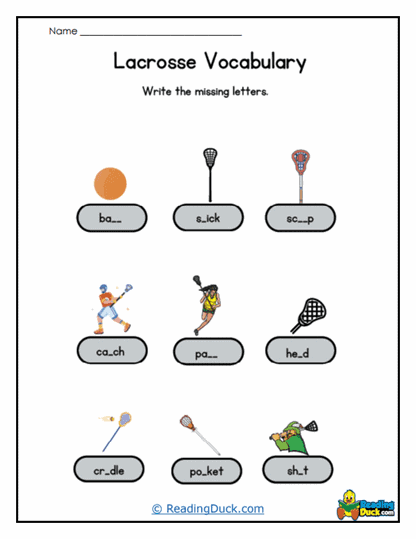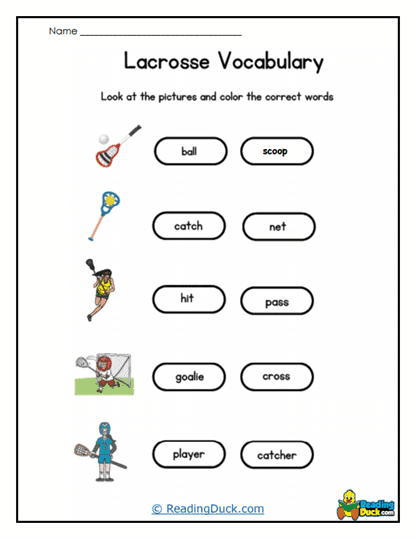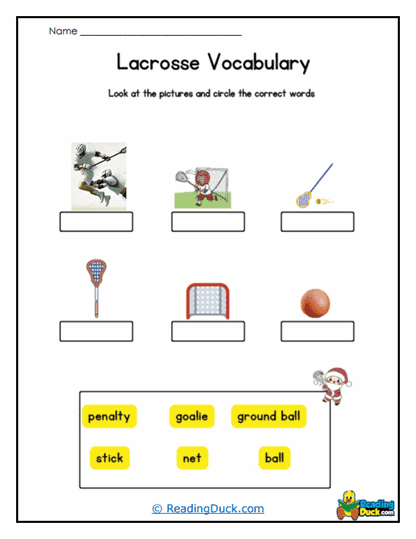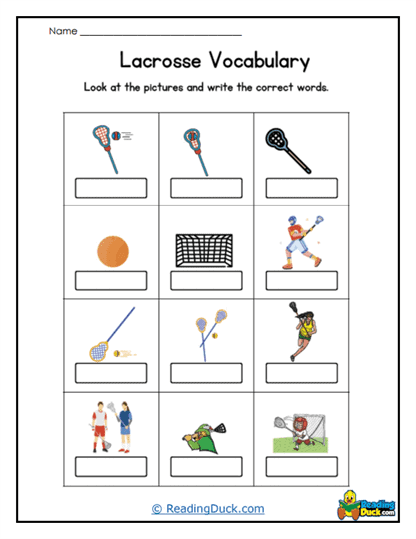Lacrosse Words Worksheets
About Our Lacrosse Vocabulary Word Worksheets
These worksheets introduce foundational terms like "face-off," "cradle," "crease," and "midfielder," each accompanied by clear definitions and usage examples. However, their value extends far beyond memorization. By engaging with these terms in context-based exercises, students enhance their understanding of how specific words function within the sport, thus bridging the gap between sports literacy and academic language skills. This approach ensures that students not only recognize the terms but also grasp their meaning and application in real-world scenarios.
These worksheets include diverse exercises such as word matching, sentence completion, and even context-based problem-solving activities. For instance, a matching exercise might pair terms like "defenseman" with their definitions, while a sentence completion task could challenge students to use the term "goalie" correctly in a sentence. Context-based activities might involve analyzing a short passage about a lacrosse game and identifying or inferring the meanings of key terms. This variety keeps the learning process engaging and ensures that students develop a well-rounded understanding of lacrosse terminology.
One of the most significant advantages is improved vocabulary, as students encounter and internalize new terms within a thematic framework. Enhanced reading comprehension naturally follows, as students are required to interpret lacrosse-related texts and apply their growing knowledge to make sense of the material. Furthermore, these exercises help sharpen communication skills by encouraging students to articulate their thoughts about the game using accurate terminology. Whether discussing a lacrosse match or writing about its rules, students gain confidence in expressing themselves clearly and effectively.
By connecting academic skills with the excitement of sports, these worksheets foster a positive attitude toward learning. Students who might otherwise be uninterested in traditional vocabulary lessons often find themselves engaged and motivated when the content is tied to an exciting subject like lacrosse. For homeschoolers, these worksheets provide an excellent opportunity to create thematic units that combine physical education, language arts, and even history by exploring lacrosse's origins and cultural significance. This multifaceted approach not only makes learning fun but also cultivates a deeper appreciation for the sport.
These worksheets encourage active learning, promote cross-disciplinary connections, and are easy to integrate into existing curricula. Teachers can use them as standalone activities, supplements to sports units, or as part of a broader effort to foster student engagement with language. For homeschoolers, they offer a structured yet flexible way to explore new vocabulary while tapping into a child's natural interests. They are an excellent example of how themed educational materials can inspire students, making learning both purposeful and enjoyable.
The Game of Lacrosse
Lacrosse is considered the oldest team sport in North America, with origins tracing back to Indigenous peoples who played it as early as the 12th century. Known as "stickball," these early games could last for days and often involved hundreds of players spread across fields that stretched miles. The sport held deep spiritual significance, serving as a method of conflict resolution, a training exercise for warriors, and a ceremonial practice to honor the Creator. Its rich cultural history makes lacrosse more than just a game-it's a symbol of heritage and tradition.
Modern lacrosse is one of the fastest-paced sports in the world, often referred to as "the fastest game on two feet." Players sprint up and down the field with incredible agility while passing a small rubber ball using lacrosse sticks at lightning speeds. In professional games, balls can reach velocities of over 100 miles per hour during shots. This blend of speed, skill, and endurance demands top-notch athleticism, making it a thrilling sport for both players and spectators.
Lacrosse is unique in its use of specialized equipment. The lacrosse stick, also called a crosse, features a netted head designed for catching, carrying, and throwing the ball. Players develop remarkable coordination to cradle the ball while running, dodging opponents, and executing precise passes. Goalies, equipped with larger sticks and extra padding, face shots from close range, demonstrating exceptional reflexes and bravery. The gear's evolution over centuries-from handcrafted wooden sticks to today's high-tech materials-highlights the sport's blend of tradition and innovation.
While lacrosse has strong roots in North America, its popularity is exploding worldwide. Organizations like World Lacrosse have fueled the sport's expansion, introducing it to new countries and international competitions. Lacrosse made its Olympic debut in the early 20th century and is set to return as an official sport in future games. Colleges and high schools are increasingly adopting it, making lacrosse one of the fastest-growing sports globally. This global reach showcases how a game rooted in ancient traditions continues to inspire and captivate new generations across the world.
Lacrosse Vocabulary Words That We Explore
1. Cradle - The motion of moving the stick back and forth to keep the ball secure in the pocket while running or maneuvering. Cradling uses centrifugal force to keep the ball in place. It is a fundamental skill in lacrosse that helps with ball control and evading defenders.
2. Face-Off - A technique used at the start of play or after a goal to gain possession of the ball. Two players crouch with their sticks on the ground and compete for control of the ball. The referee blows the whistle to signal the start of the face-off.
3. Ground Ball - A ball that is loose on the ground and not in possession of a player. Players use their sticks to scoop the ball up into the pocket. Winning ground balls is critical for gaining possession and creating scoring opportunities.
4. Scoop - The action of picking up a ground ball with the lacrosse stick. The player positions their stick low to the ground and accelerates forward to collect the ball. Proper scooping technique helps maintain game speed and possession.
5. Dodging - A maneuver used by offensive players to evade defenders. Common dodge types include the split dodge, roll dodge, and face dodge. This skill is essential for creating space and advancing towards the goal.
6. Check - A defensive technique used to disrupt an opponent's possession of the ball. Stick checks, such as poke checks and slap checks, are used to dislodge the ball. Body checking is allowed in men's lacrosse within the rules.
7. Crease - The circular area around the goal that marks where only the goalkeeper can stand. Offensive players cannot enter the crease but can reach into it with their stick to score. This zone protects the goalie from interference.
8. Assist - A pass made to a teammate that directly leads to a goal. Assists are a critical part of team play and help create opportunities for scoring. They are recorded as a statistic to highlight teamwork and offensive contribution.
9. Man-Up - A situation where a team has more players on the field due to a penalty on the opposing team. This creates a temporary advantage to score goals. Teams use specific strategies during man-up situations to capitalize on the advantage.
10. Man-Down - A scenario where a team is at a numerical disadvantage because of a penalty. Defending while man-down requires strategic positioning and communication. The goal is to prevent the opposing team from scoring during this time.
11. Clearing - The act of moving the ball from the defensive end to the offensive end. Teams use clearing strategies to transition into an attack. Success depends on accurate passing and avoiding interceptions.
12. Ride - A defensive tactic to prevent the opposing team from clearing the ball successfully. Players apply pressure and block passing lanes. Riding is crucial for regaining possession after a turnover.
13. Offside - A rule violation that occurs when a team has too many players on one side of the field. Each team must maintain a specific number of players on their offensive and defensive sides. Offside results in a turnover or penalty.
14. Pocket - The mesh part of the lacrosse stick that holds the ball. The depth and tension of the pocket affect ball control and throwing accuracy. Players can adjust the pocket within regulation limits for personal preference.
15. Fast Break - A quick transition play where the offensive team attacks the goal with a numerical advantage. Fast breaks often occur after a turnover or face-off win. They are high-paced and require precise passing and decision-making.









